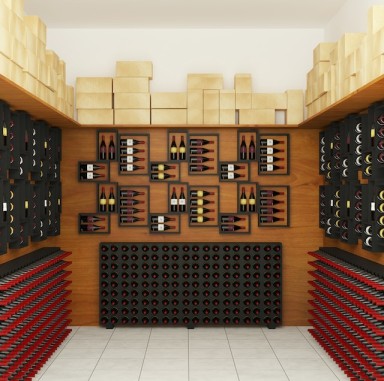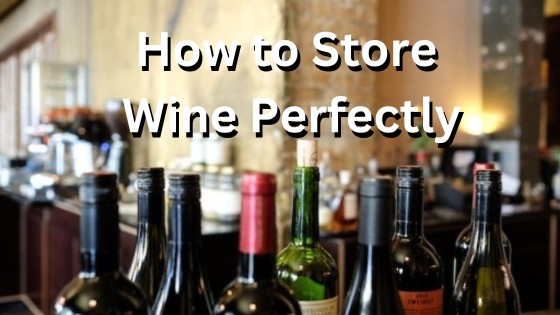Last Updated on January 2, 2023 by CHANDRAMANI
Wine is significant in many cultures and has moved from an important source of nutrition to a cultural complement to food. Also, it is used for gifting and drinking on special occasions.
Wine has to be stored in proper conditions before serving as it ultimately affects its taste. Storage temperature determines the evolution of primary, and secondary aromas and wine color.
While it’s good to build a wine cellar for long time storage but for short storage, a good fridge is great for storing wine before serving, nowadays you can get a good wine fridge for under $300.
An ideal storage recommendation is to store wine in a cool(about 13 °C) and dry place, away from direct light and vibration but in proper humidity(70%). Corked wine should be stored on their side to keep the cork moist and tightly sealed, while screw caps can be stored standing up.
Table of Contents
Tips for Storing Wine at Home
Many people store wine bottles in the living room, kitchen, dining room, or on fridges without knowing that these are not the best places to keep your priceless wine.
If wines are stored properly then red wines get lighter with age while white wines get darker near to golden with age.
1. Build Wine Cellar or have a Fridge

It’s always good to build a wine cellar if you want to store your wine for a long time storage. Choose a location that is away from light and vibration and that is in a cool place.
If you have a basement then, it is a perfect place to build a cellar because it’s more humid and much colder than other rooms in the house. Also, it is free from vibrations and sunlight which makes it easy to provide perfect conditions.
For short-time storage of about a month or two, wine fridges are good and you can keep your wine in them without worrying about temperature fluctuations or humidity. Also, before serving Ideal serving temperatures: Red Wine: 12˚C < 19˚C, White Wine: 8˚C < 12˚C which you can get by storing the wine bottle in a fridge.
2. Store at a Cool temperature without any fluctuation
Always store wine in a cool environment, without any temperature fluctuation. The ideal temperature range is between 45° F and 65° F (and 55° F is often cited as close to perfect).
Red winemaking benefits from slightly higher temperatures of 1-2 degrees because they facilitate the skins’ extraction of color, phenolics, and tannins.
However, too higher temperatures make wine age prematurely as it accelerates chemical reactions. It may also imprint cooked flavors and increase oxidation Constant temperatures all year round is essential for the wine to mature correctly.
Too much cold also is not good as it dries the cork and air can seep into it and start oxidation as a result of oxygen which enters more in amount because of the compromised cork. It turns wine ethanol to turn into acetaldehyde also called vinegar and is known as a wine fault.
So don’t store it in a garage or anywhere where it is too cold. If you have a basement it is good or in a closet where temperature fluctuations should not be more than 10 degrees.
Wine flavor and aroma differ depending upon its storage temperature. According to research wine flavor and aroma is preserved at lower fermentation temperature.
3. Protect Wine from Light and Vibration
Keep wine bottles in dark environments as much as possible, especially those which come in transparent bottles. Keep away from windows or lamps it can develop aromas from oxidation or volatile sulfur compounds.
Sunlight damages wine very quickly because of UV rays plus the heat that cooks the wine. Direct sunlight and electric fluorescent and UV lighting (in your wine cellar, for example) can all cause wine faults.
The colored foil on sparkling wine bottles is present to protect them from light, so do not remove them.
Vibrations are also bad for wine, especially for red wines. Vibrations can cause particles to separate and fall into the wine. Keep away from noisy electric appliances.
4. Store Wine Bottles Horizontally
Wine with corks on them should be stored on its sides so that the cork remains moist and remains tightly sealed. This limits the amount of oxygen entering the wine and prevents faster maturation.
As long as the wine is there in the bottle, the humidity present inside doesn’t allow the cork to dry. Keeping it horizontal will prevent air from getting in and spoiling your wine.
Sparkling wine has air pressure to keep them carbonated so it’s not recommended to store them horizontally as it may affect its air pressure.
5. Maintain Proper Humidity
Although many wine coolers offer a range of 55% to 85%, the ideal range for long-term wine storage is between 60% and 86%.
When humidity levels are lower than recommended percentage the wine cork dries up and allowing more oxygen and leading to quicker wine maturing. Also, too low humidity levels can lead to cork being slip out and wine being spilled.
Over humidity is also bad for the wine as corks can dampen and allow more oxygen to enter and spoil the wine.
For proper humidity, you can invest in wine coolers for storage. They have proper storage conditions to store wine before you can drink it.
You can also opt for outside storage of your wine where you can rent a locker where they have climate control conditions perfect for short or long time storage. The charges are usually $2 to $4 per bottle, where you don’t have to worry about your wine getting spoilt.
However, keep in mind that the recurring payments add up to the price of your wine price. So, it’s good if you have costlier wine bottles that you don’t want to get spoilt and lose tons of money, and is not good for cheaper wine bottles.
6. Store Opened Wine Bottles in Fridge
While most opened red wines last 3-5 days, better quality last for about 2 weeks, sparkling wines last up to 1-3 days but are still drinkable a few days after.
Opened wine gets spoiled due to oxygen, so put the cork or caps tightly after drinking and put it in the fridge. Refrigeration slows down oxidation.
You can use small bottles and transfer the leftover from the large bottle to a smaller one so that less air is inside it. If you are not able to close the opening of the wine bottle properly with screw caps or cork, then use a small plastic wrap and put rubber bands over the wrap.
Read Next: Mini Fridge for Kegerator

